We were away for over a week and we seemed to have missed a week of rain although the temperatures were not low. I thought things might have started to change in the garden.
But no: the Goldfinches are still dining on the Cosmos seeds.
The stray Hollyhock in the vegetable garden is flowering happily with no sign of rust despite the rain.
The bees are happy to visit for the nectar but I would not think she would want all that pollen she has stuck onto her at this time of year.
The Medlar tree is heavily loaded with fruit this year but it is not ripe yet.
It has been so mild that even the little olive tree has given us some olives but it will be a long time before we get enough to do anything with them.
I love the colour of the Persimmon tree at this time of year and I had thought that the mild year and warm autumn would give a bumper crop.
However, it has not been an exceptional year and we better get them off the tree tomorrow or else the birds will peck them all. I thought it was all the Blackbirds fault but this Blue Tit (Cyanistes caeruleus) has been caught in flagrante delicto.
It was only after taking the photograph that I realised the Tits (a Great Tit ( (Parus major) here ) were being helped by a Blackcap ( Sylvia atricapilla), well the free-for-all will end tomorrow and it will be back to peanuts and sunflower seeds for them.
I was pleased to see my winter flowering honeysuckle had started to flower while we were away. I cannot be sure what kind of bumble bee this is as the buff-tailed bumble bees (Bombus terrestris) in France have white tails! So very easy to confuse with the white-tailed bumble bees (Bombus lucorum) Perhaps this winter I will have more time to hone up on bumble bee IDs.
I’m pretty sure this one is an early bumble bee queen (Bombus pratorum) as the yellow band on her abdomen was broken in the middle and the Bumble Bee Conservation Trust says this bee has the most variable colouration. If you are interested in my tentative identification of bees have a look at my other blog “Bees in a French Garden”. I am always keen to have contact with anyone interested in solitary bees.
The colours of autumn are not appearing uniformly which with the sunshine give the feeling of springtime more than autumn. My Liquidambar is turning yellow but I do not see much red in its leaves.
The cotoneasters are trying their best to provide a vivid red and are laden with berries this year.
My Physalis or Chinese Lanterns are bright red where they have self-seeded themselves here and there. They are a lovely addition to an autumn garden but I am not sure how to make the best of them. Mine seem to have a weedy growth and I wish I could make better use of them. Any tips for a better show next year?
I was pleased to see my Mahonia “Soft Caress” that I planted last January has flowered.
I planted it at the same time as my Rosa mutabilis which I first saw in Christina’s garden blog, it is such a delicate rose and virtually thornless and is full of flowers at the moment.
In fact, it does not feel at all like autumn yet.

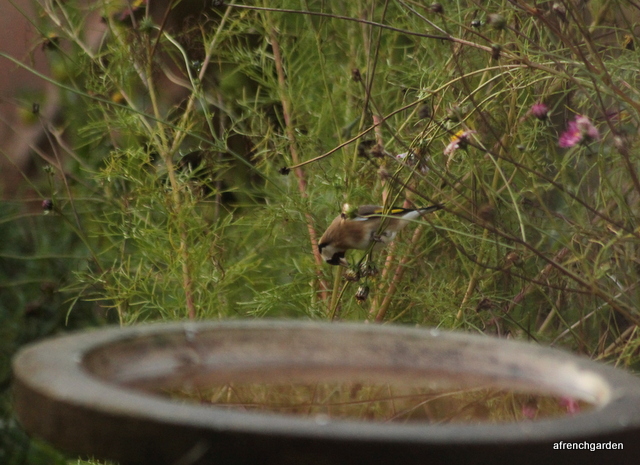

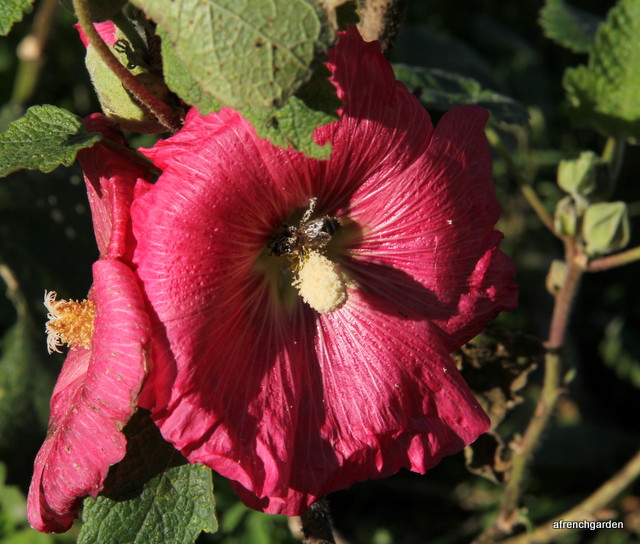
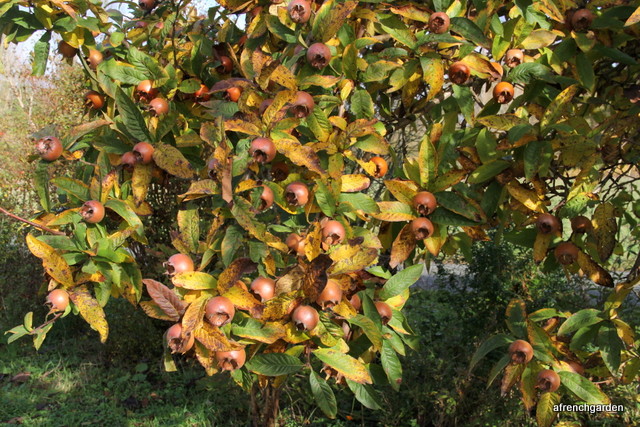
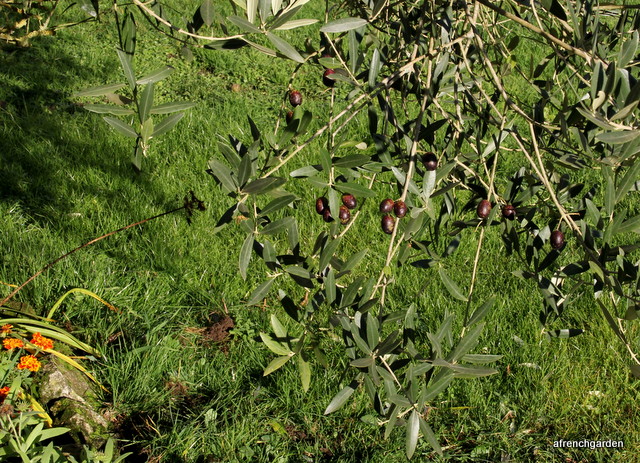
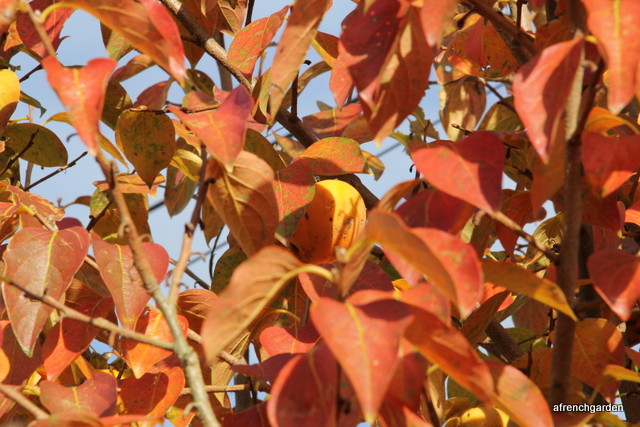
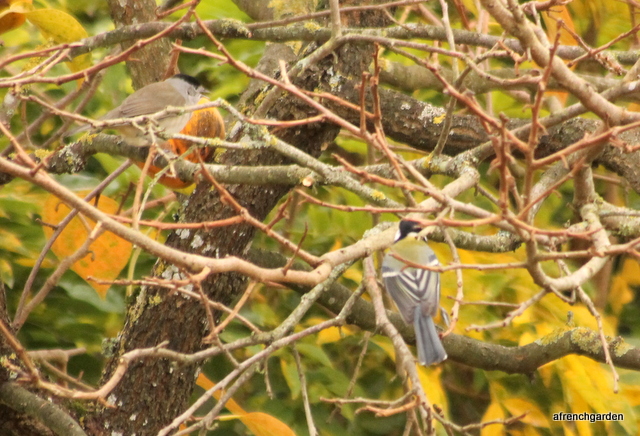

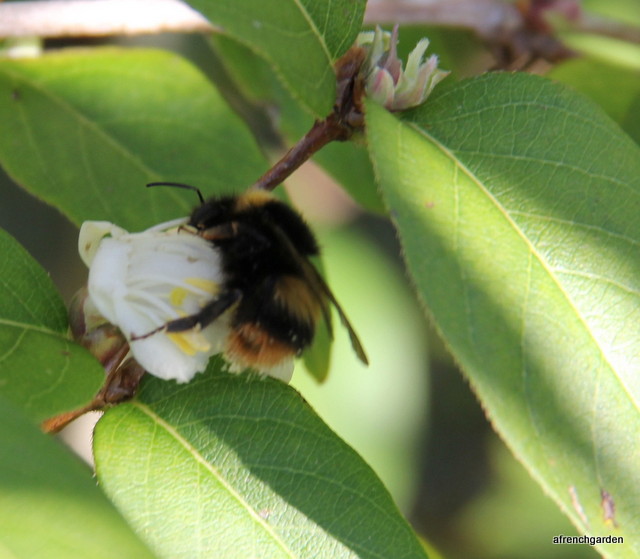

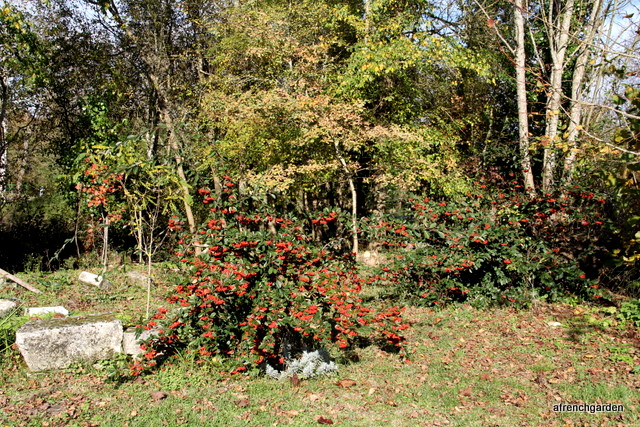

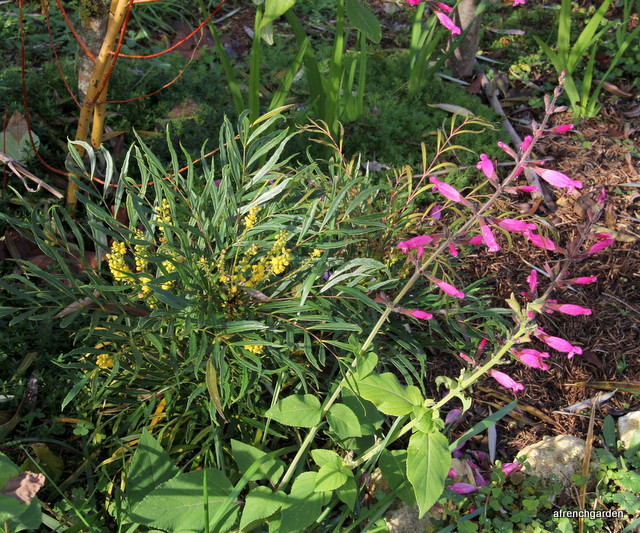
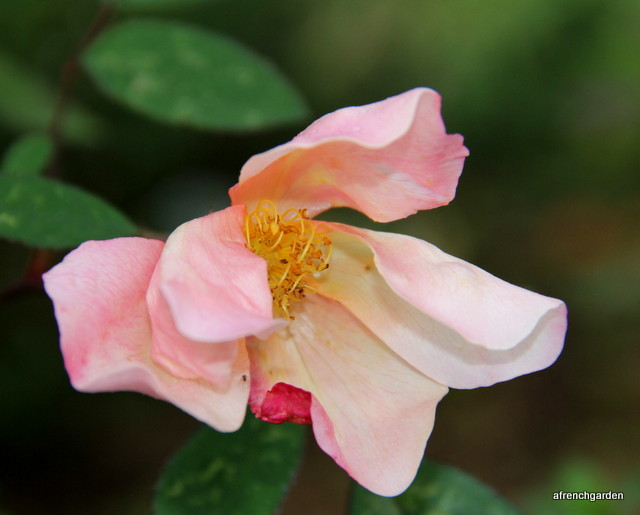
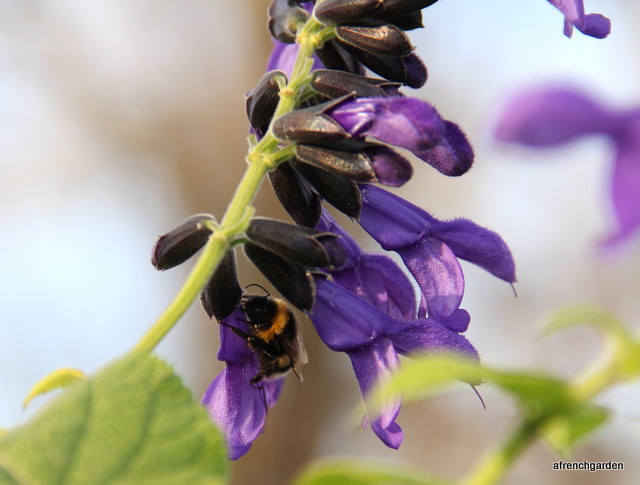
Amazing amount of pollen on that bee!
LikeLike
The Hollyhocks are always very generous with their pollen donation but I think the honeybees will be hunkering down for winter now and not be needing it for any brood. Amelia
LikeLiked by 1 person
So you still have lots of bees too, I’m so pleased you like your Mutabilis, they are more interesting at this time of year when you can see all their colour variation, in summer mine turn very quickly to deep crimson so that is the colour they all look.
LikeLike
My buds are a very deep pink and I like to watch all the colour changes. I am so pleased I got this rose. Amelia
LikeLike
That’s interesting mine starts pale apricot and they changes to pale pink then deep Crimson, in summer they change almost as soon as they open, but now there are more pale pink and very few deep coloured flowers.
LikeLike
Mmm. I’m wondering if it could be to do with temperature. I am growing some Hibiscus cuttings which my son assures me have different colours of flowers according to the temperature but that remains to be seen.
LikeLiked by 1 person
What a surprise–no sign of winter there at all. Here we were socked in by an early November snow, followed, now, with an ugly thaw. Weather wildly swinging from one extreme to another. I don’t expect any more bees this year.
LikeLike
I was talking to a cousin in Seattle and they got your freezing weather but not the snow. It is very unusual for them to get such freezing weather at this time of year. I prefer our unusual weather, though. Amelia
LikeLiked by 1 person
Lucky you having bumbles around still, I haven’t seen any in London for a while. Exciting that you have the ‘Bees in a French Garden’ blog now!
LikeLike
I have the queen bumble bees to keep me company on warm, sunny days throughout the winter. That is why I have planted more Mahonia and winter flowering honeysuckle, even the honeybees will come and visit them too. I had hoped to meet electronically with other solitary bee lovers but we are definitely few and far between. Amelia
LikeLike
The Chinese lantern likes full sun and better than average soil to do its best. A little pinching in spring might help it bush out more, too.
I must be nice to live in a place where the seasons aren’t so far apart weather wise.
LikeLike
I think my sad specimens would benefit from more sun as I usually don’t notice them until autumn. Perhaps next year I can put some in a better position for light to give me some more autumn colour. Thanks. Amelia
LikeLike
So lovely to see all the wild life in your garden – it is certainly looking more spring than autumn in your photos!
LikeLike
We often have warm sunny days in autumn but I have never experienced such strong sunshine and such high temperatures during the day in November. Amelia
LikeLike
Very nice . . . a far cry from our conditions.
LikeLike
I have seen on the news that the USA has had a cold blast to start off their winter. Amelia
LikeLike
Lovely post… again!
I would love to have a Liquidambar here…
but they do not like alkaline soil…
but… I shall just have to enjoy pictures of yours when you post them!!
The Great Tit caught eating your Kaki is, in fact, a Blue Tit…
note the white tonsure and blue pate…
the next picture, with that thieving Blackcap….
contains a Great Tit… all black head and olive green back….
queueing!!
Tits, Blackcaps, and many other warblers & small insectivores, just love fruit…
our cherries get a hammering from them all in season…
I suspect it will be instant, liquid fuel they are getting…
so please leave the damaged Persimmons in place.
As for unseasonable warmth…
I downloaded the data from our weather station this Friday and checked back through the last three years…
which is as long as I’ve been using the current software…
which unfortunately doesn’t recognise previous data…
not without a lot of fiddly conversion…
but 2012 had a November mean temperature of 7.2 Centipede…
as did 2013 at 7.1 Centipede….
but up to Friday, 2014 the mean for this month is a staggering 10.8 Centipede!!
Almost four degrees warmer…
Is it any wonder that many flowers are still bloomin’ or even restarting…..
LikeLike
Thanks for the ID. I can easily tell which are which when they have the decency to sit beside each other but when they are at a distance from different angles I have problems. I will leave them the pecked fruit and bring in the rest to ripen indoors. If you fancy a Liquidambar, I’d have a go. The RHS says acid to neutral soil but mine is calcaire and it has survived from tiny and been moved once too! I just don’t think I’ll get the lovely red colours. The average temperatures are very interesting but I don’t think the very high day time temperatures and strong sunshine show up as strongly in them. I see a lot of flowers restarting – even the sunflowers are popping up in the fields where they were harvested not long ago. amelia
LikeLike
It’s wonderful to see you’ve got fruit, bee, flower and fall color action going all at once. I hope to spend more time this winter reading up on solitary bees. I didn’t do well identifying them this past season because I couldn’t see them very well and my attempts at photographing them didn’t help. I may try briefly catching them to observe in something like a glass tube but I don’t want to interrupt their important work for too long.
LikeLike
I felt like that too but I think just taking 20 minutes out of their day is not too much. 15-20 minutes in a plastic pot in the fridge does not harm them and it is the only way to keep them still enough to get a look or photograph good enough for a genera ID. I got one of these pots for kids to look at bugs in. Any little clear pot with a lid would do. I think Bug Guide http://bugguide.net/node/view/475348 is very good for bees in the States. Amelia
LikeLike
It doesn’t really look like autumn yet either! Fruit, bees and flowers at the end of November is simply a treat Amelia. Enjoy the rest of your lovely long season, whatever you may wish to call it. We are heading into winter now, with our first frosts, albeit not hard ones.
LikeLike
I am enjoying the unusual warmth in the garden at the moment as I have a lot of things to plant and move this year and I am not really a frost hardy gardener. Amelia
LikeLike
My liquidamber, planted four years ago, has just been destroyed by deer. I’d like to plant a medlar too – but obviously it will have to be in a protected spot. D
LikeLike
It is really sad to lose a tree like that. We have lots of deer around here but so far we have had no damage in the garden. There are a lot of beech, chestnut and oak in the thickets around us which are I hope a lot tastier than my trees. Amelia
LikeLike
Nice to see the bees still active in your garden. I havnt seen a bee here for a few weeks, it doesnt help that the weather has been very wet. Philip
LikeLike
Rain certainly keeps the bees away. Even honey bees prefer going out for their cleansing flights in the cold rather in the rain. Amelia
LikeLike
I am so looking forward to retiring to France in a few years time – very jealous
LikeLike
This is a really exception year, we don’t get weather like this every year! Amelia
LikeLiked by 1 person
Your very late Autumn colour looks wonderful Amelia, I’ve just followed your link to your other blog, looking forward to updates.
LikeLike
We had a beautiful fall here too in the US, until the polar vortex swept in, although that cold was brief. It will be in the 70s (F) today.
I always enjoy the pictures and tales of wildlife in your garden, and seeing the European cousins of our American birds and bees.
Is that an American or Asian species of sweetgum? It looks very much like the ones we have here.
LikeLike
I would imagine my Liquidambar is the American sweet gum. I don’t get very good details of the varieties of plants I buy here in this region of France. I often buy plants in the U.K. and bring them over in the car as I can get a species and a variety. The Liquidamabar is supposed to like acid soils but mine is on lime which goes to show sometimes you have to just give things a chance and have a go. Amelia
LikeLike
Wel jel! Had to scrape the ice off the car this morning. -2.5 degrees.
LikeLike
Everybody is really appreciating this mild November over here. It has been particularly handy for me as I’ve had a lot of things to plant and change place this year and I am a bit behind with it. I am told that today is St. Catherine’s day and everything planted today will take root, I would have told you sooner – if I had known! Amelia
LikeLiked by 1 person
Lovely photos, and I particularly like the Rosa mutabilis – a really pretty flower. Does it have any scent or hips. Or just these gorgeous flowers? And do the bees like it?
Best wishes
Julian
LikeLike
I admired it first in Christina’s Italian garden and it can have a light perfume. I ordered it hurriedly by internet while in the U.K. last Christmas and did not check. It is not a perfumed variety but it has charmed me because it has no thorns and fine stems. I believe you can get lightly perfumed varieties of the same species. It does not attract the bees like Madame Isaac Pereire but this is just its first year. Amelia
LikeLike
Autumn has arrived here in England but very late.
LikeLike
I think most of Europe has enjoyed a mild autumn, I wonder if it will mean another short winter. Amelia
LikeLike
Certainly doesn’t look like November. But beautiful, oh yes.
LikeLiked by 1 person
Thank you for the pictures of the winter bumbles. Now I know that bumbles can forage in winter, I’m always looking for them in London. Perhaps your garden is more tempting!
LikeLike
I saw one the other year at Christmas time on a Mahonia in the grounds of the National History Museum near the ice rink. Amelia
LikeLike